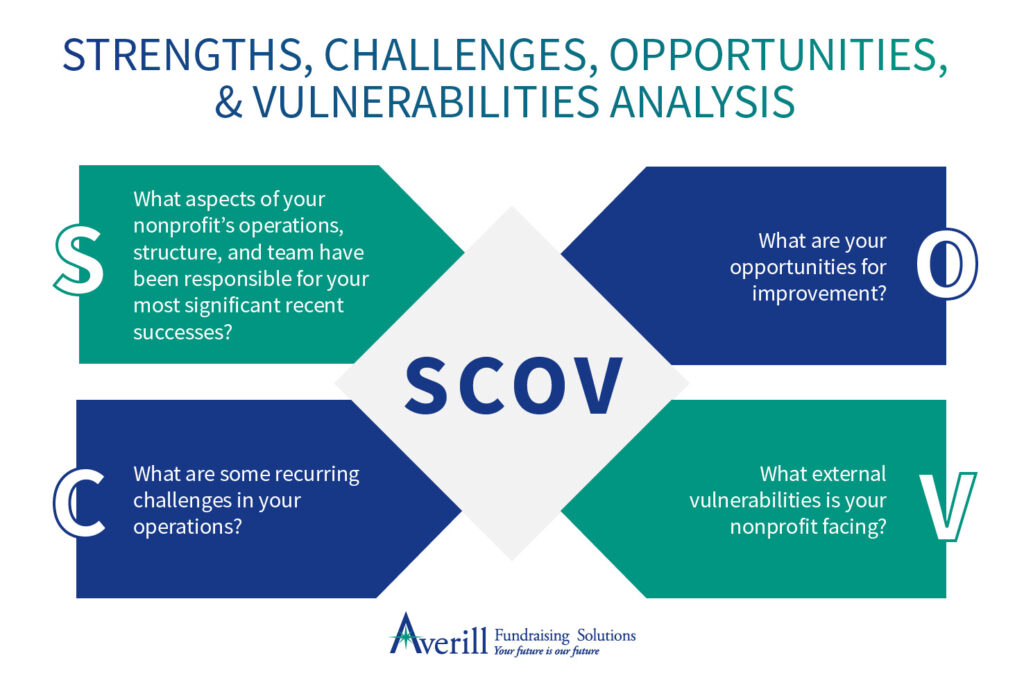When you think about your nonprofit’s future, what do you envision?
You might think about serving more constituents, diversifying your source of fundraising revenue, expanding your volunteer program, or hiring more employees. Whatever your specific vision is, you’ll need a clear plan on your side to help you get there.
That’s where a nonprofit strategic plan comes in, in which you identify how you’re going to reach your long-term goals.
To set your organization up for success with strategic planning, we’ve put together this quick guide that will cover all the basics you need to know, including five steps for building out your strategic plan. Let’s begin.
The Basics of Nonprofit Strategic Planning
Averill Solutions defines a strategic plan as “a document that lays out the goals that will get you closer to accomplishing your mission.” These plans are usually designed around what you want to accomplish in the next three to five years.
When you engage in strategic planning, you should involve multiple stakeholders to ensure you’re creating goals that truly align with your mission and are well within your organization’s ability to accomplish. Some stakeholders you might involve include:
- Board members. Your board has the responsibility of governing and directing your organization so that it can successfully serve constituents and secure a sustainable future. Board members can provide valuable input on what will be best for your organization in the long-term.
- Staff. Whether they’re volunteers or paid employees, your staff members are the ones who conduct the day-to-day work of running your organization and furthering your mission. As a result, they’ll be able to help you break your goals down into actionable steps that can be woven into their regular workflows.
- Key community members. Major givers, local business owners, and other key community members like politicians should also be involved in strategic planning. Not only does this give your organization an opportunity to engage with these individuals, but they can help you see what goals and actions will have the biggest impact on your community.
In addition, many organizations choose to hire a nonprofit consultant to assist with their strategic planning process, as these experts have typically helped many organizations build out (and accomplish) plans for the future. (More on this below.)
5 Steps To Building a Strong Strategic Plan For Your Nonprofit
Now, let’s get into the nitty-gritty of actually building out your nonprofit’s strategic plan. Here are five steps to follow to ensure that you’re creating a plan that will yield real results:
1. Assess your nonprofit’s current standing.

Before you can plan out where your nonprofit wants to go, you need to take a step back and assess where you are. An effective way to do this is to conduct a strengths, challenges, opportunities, and vulnerabilities (SCOV) analysis. Here’s how:
- Strengths: Identify the aspects of your operations, organizational structure, and team that have helped you achieve your most recent or impactful successes.
- Challenges: Determine the hurdles your nonprofit often faces when it comes to achieving goals, whether that be consistent staff turnover or challenges cultivating major giver prospects.
- Opportunities: Based on your current strengths and challenges, consider possible opportunities to improve your operations. This might involve building new skills, experimenting with different fundraising methods, improving your financial practices, or investing in new tools.
- Vulnerabilities: Vulnerabilities are external challenges that your nonprofit is facing. For instance, is economic downturn or social unrest affecting your fundraising goals or operations?
Once you have a clear picture of your organization’s current standing, you can start planning for the future with eyes wide open.
2. Set measurable and achievable objectives.
The next step in building your strategic plan is to take the broad goals or visions you have for the future and distill them into specific and measurable objectives.
For instance, say that you want to expand your giver base. You might outline a specific objective related to acquiring more givers, which could involve creating a new series of welcome emails for new newsletter subscribers and sending first-time givers a small gift to show your appreciation and excitement for their continued support.
The more granular you can make the action steps for achieving your objectives, the more manageable they will feel for every team member involved in them.
3. Identify capacity-building projects to help you reach your objectives.
In many cases, you may need to create objectives that will help you build your organization’s capacity to serve its community, thus increasing your impact and moving you closer to accomplishing your mission.
A capacity-building project could be something as large as a full-scale capital campaign that helps you build or renovate a facility, or something else, like:
- Mapping out a succession plan for your organization
- Recruiting more volunteers
- Training your team in a new skill
- Expanding your network of professional connections
- Designing and launching a membership program
- Revamping your organization’s website
The main idea behind capacity building is that your nonprofit will increase its resources or skills to do its job more effectively, so make sure you choose something that will encourage growth across your entire organization!
4. Determine the roles your team members and community will play in carrying out the strategic plan.
At this point, you’ll want to turn again to your organization’s board members (and other leaders), internal team, volunteers, and community partners. Give individuals or teams tasks that suit their roles, responsibilities, and skill sets, and set a clear deadline for when each task should be completed. You can also outline specific reporting expectations and a schedule for checking in on everyone’s progress.
As you embark on actually putting your strategic plan into action, make sure to keep your entire team motivated. You can do this by consistently reminding them of your larger end goals and celebrating the progress that everyone makes and milestones met.
5. Be prepared for your plan to change.
Sometimes the only thing you can plan on for sure is that things will not always go according to plan.
Prepare from the beginning of your strategic planning process to encounter hiccups along the way and for changes to be necessary. If you anticipate the need for pivoting and adapting, you’ll be more prepared when you actually have to do it. Here are a few tips to follow to help your organization be flexible during these times:
- Identify more than one way to reach your goals. Always have a Plan B in mind. For instance, you could have a goal to upgrade all of the technology in your organization’s facility. Initially, you might plan to conduct a capital campaign to do this. But if you discover through a feasibility study that your organization isn’t quite ready for such a large project, it will be ideal to have another plan in mind, such as seeking out a technology grant.
- Communicate regularly with everyone involved in your plan. If the need for change arises, don’t keep it from your team. Be transparent and communicative with everyone. This will help with morale and also means that you’ll have more people thinking about how you can pivot to a successful path.
- Stay positive. Don’t get discouraged when challenges come. Instead, view them as stepping stones toward your larger strategic planning goals. Accepting that challenges are a part of the process means that you’ll spend less time worrying about them and more time navigating through them.
It’s normal to experience unexpected twists and turns in your journey to carrying out your strategic planning goals. But if you’re prepared to handle them, your organization won’t be stalled for long.
How a Strategic Planning Consultant Can Help
A nonprofit consultant can be a great asset throughout the strategic planning process. These experts understand the importance of nonprofit missions and the goals organizations set to accomplish them. Plus, they have experience helping multiple nonprofits reach their goals and can offer an objective, third-party perspective on your plans.
If your organization could benefit from the guidance of an experienced strategic planning consultant, follow Averill Solutions’ steps to hire the right fit:
- Identify your goals you have for working with a consultant and the services you need.
- Use your network to identify consultants you’d potentially like to work with.
- Meet with your top consulting candidates.
- Request proposals from your shortlisted candidates and review them, then check their references.
- Once you’ve identified the consultant you want to work with, sign a contract with them and get to work on strategic planning!
During the hiring process, be attentive to each consulting candidate’s communication style. You want to work with someone who takes a collaborative approach, is an active listener, and understands that you ultimately know what is best for your specific organization.
Thoughtful strategic planning is essential for achieving the future state you dream of for your nonprofit. Use this miniature guide to navigate the process of building your own strategic plan, and remember to turn to an experienced nonprofit consultant for assistance when you need it!
Author: Bob Happy
Bob Happy brings nearly 35 years of experience providing expert leadership and direction to clients across the not-for-profit sector to his current role as President of Averill Solutions. Before forming Averill Solutions, Bob served as the Executive Vice President and Chief Operating Officer of the nation’s largest fundraising firm. He has mentored hundreds of professional fundraising practitioners and many have joined him at Averill Fundraising Solutions.
